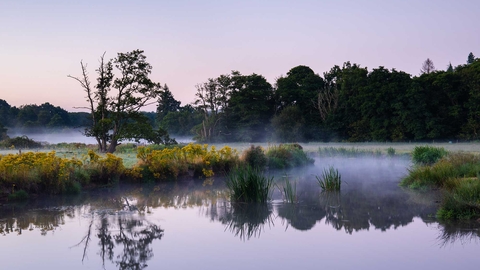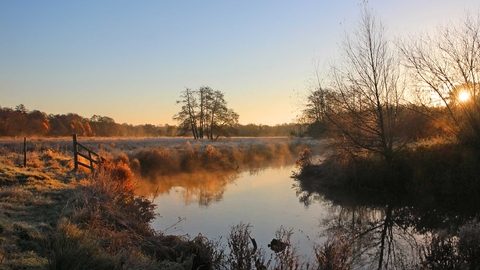
© Alan Crossland

© Kate Cheal

© Jon Hawkins
Thundry Meadows
Location
Know before you go
Dogs
Guide dogs and Assistance dogs only
When to visit
Opening times
Open at all timesBest time to visit
April to AugustAbout the reserve
Part of the Wealden Heaths 'Super' National Nature Reserve (NNR), Thundry Meadows is a peaceful wetland nature reserve set along the banks of the River Wey in the village of Elstead.
Come to Thundry Meadows any time from early spring to late autumn and you’ll find a dozen young belted Galloway cattle working hard to keep the site in prime condition. For example, their selective munching of the tussocky grassland near the entrance has created an ideal habitat for harvest mice.
Reptiles including the grass snake and common lizard use this area as a winter refuge. Further west there are dozens of anthills covered in mouse-eared hawkweed, with distinctive white hairs on its leaves. Dyer’s greenweed is here too, but becoming less common, as ground that was once limed reverts to its natural acid condition.
Among the notable flowers, the devil’s bit scabious is an important late nectar source for insects. Veteran birches, some almost standing deadwood, and marsh thistle attract invertebrates, which provide abundant food for goldfinches and other birds.
As you move through different fenced sections (or compartments) the habitat changes to alder carr scattered with birches. Here the wet ground is criss-crossed by a network of ditches, originally dug as WWII tank defences and now fed by natural acidic springs.
Look carefully and you’ll see the tiny yellow flowers of opposite-leaved golden saxifrage. It is threatened by highly invasive Himalayan balsam, which the Trust’s dedicated volunteers regularly clear, along with hemlock water dropwort, which is poisonous to cattle.
Between woodland and river, a pond is home to amphibians, dragonflies and greater spearwort. Thundry has more than 50 bat boxes, installed and monitored by Surrey Bat Group, and a WWII pillbox has been turned into a bat hibernaculum thanks to a grant from the Heritage Lottery Fund. On the riverbank hazel screens and groynes create calm pools and protect against erosion. Water forget-me-nots and dragonflies are returning and an iridescent reed beetle (Donacia bicolora), which lives on branched bur-reed, is a notable summer presence.
Looping back towards the site entrance, you encounter Thundry’s most remarkable habitat: one of the few examples of quaking mire in Surrey. This is a mat of vegetation floating in liquid peat, which is home to bog-bean, ragged-robin, marsh cinquefoil, white sedge and star sedge. Among the plants, raft spiders dip their front legs in the water to detect prey.
Accessibility and facilities
- This site does not have a car park - limited parking in lay-by on Farnham Road.
- There are no accessible self-guided trails at this site.
- Paths are unmade and may be uneven and slippery in places.
- There are no refreshments or toilets on site, but The Mill pub is very close by.
- This site is not suitable for wheelchair and mobility scooter users, or people with serious mobility issues.



